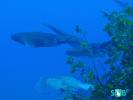 Advice on Scuba Diving in Tsushima and Iki Island, Japan
Advice on Scuba Diving in Tsushima and Iki Island, Japan
Part 1: Overview of Scuba Diving in Tsushima and Iki Island, (Japan)
Tsushima Island lies west off Japan's mainland towards Korea. For scuba divers, Tsushima Reef at 34ºN offers a chance to explore the northernmost coral reef (so far discovered) in the world. Amazingly, the Tsushima Reef was only discovered in July 2012. The dive site along the reef has just recently started drawing in curious scuba divers who want to see the coldest reef in the world through their own mask. The water temperatures along Tsushima Reef drop to 13º C (55º F) during the winter months. These temperatures are far below the 18º C (64º F) temperatures science previously thought limited coral reef formation.
Tsushima Island lies in the Tsushima Strait, the eastern channel of the Korea Strait. The Tsushima Current, a warmer branch of the Japan Current, known as Kuroshio, passes through the Tsushima Strait, bringing with it abundant marine life. Japanese fisheries harvest the life that flows through the strait, bringing to market big fish such as the Japanese amberjack and Japanese horse mackerel. Unfortunately, overfishing and pollution from nearby countries, notably China and Korea, have poisoned and depleted the waters. In the last decade, the Tsushima Current yields less and less fish and more blooms of jellyfish and waste.
Tsushima is divided into North Tsushima Island and South Tsushima Island by an artificial canal system first created in the mid-1600s. Tsushima proper also includes about 100 smaller islands. Recreational scuba diving on the island began back in 1997 and is for the most part concentrated off the northeast coast of the Tsushima's southern island of Shimojima. The fishing industry had long dominated and pushed out the leisure diving industry until recently.
The islands climate is relatively warm due to the warm maritime climate of the Tsushima Strait. The average air temperature is 15.5°C (59° F). Evergreens and deciduous trees grace 90% of the island and the distinct cypress tree is a common sight. The island offers a lot of options for tourists. The hilly island takes about three hours to drive from its northern to southern tip, and the option of cycling the length of the island has become popular. Hiking to the top of Mt. Shira-take or enjoying the many harbors of Tsushima are other favorites when you are not scuba diving.
Part 2: Dive Sites, Marine Life & Environment in Tsushima and Iki Island, (Japan)
Tsushima Island and Iki Island are relatively new scuba diving destinations; official dive sites are few and the diving industry is in its infancy on the islands relative to the tropical Japanese islands to the far south such as Okinawa. Reportedly, the best shore diving off Tsushima is on Ohtahama Beach, off the town of Mitsushima. About 30 meters off the beach, there are four sided cement objects that have been placed as artificial reefs in 3-7 meters of water called tetrapods. This dive is good to get your fins wet and for beginners who want to dive off Tsushima.
The dive site known simply as Dokutsu (“cave” in Japanese) is the southernmost of the official dive sites in the area south of the town of Tsushima. The three cave entrances along the shore are half in water and perfect for beginner cave divers. You can get back in the cave enough to get into deep darkness, and the sunlight that shines in through the entrances is beautiful when making your way back out of the entrances. Another dive north of the caves is Kamabutase, a reef dive in a small bay where the reef goes down to about 25 meters. This is the richest dive site in eastern Tsushima for marine life. You can commonly see big, mature grouper and cardinal fish. When the current picks up schools of Japanese amberjack (also called yellowtail) spiral, making a show. The dive site is for intermediate dive skills due to currents. Another dive off the same eastern coast is a large flat reef area appropriate for all levels of divers known as Deka Matsu. The current is usually weak and allows you to explore the huge specimens of wire coral. The dive site's name itself means large “Deka”, wire coral “Matsu”. Young grouper live around the coral, as do schools of Pacific herring and bottom feeders fish known as Chicken grunt. The three mentioned dive sites: Dokutsu, Kamabutase and Deka Matsu are all accessible by boat from Takahama Gyoto, a small fishing port on Tsushima's east coast.
While 90% of the world's coral reefs are found in tropical waters, Tsushima reef is in relatively cold water. In fact, it is the coldest coral reef known on the planet. The reef lies out in the murky bay between Tsushima and Iki Island. Another cold-water reef closer to Iki Island was discovered in 2001, and until Tsushimi reef was discovered in 2012, the reef off Iki was the northernmost reef yet discovered. The newly found Tsushima reef is 70 km (43 miles) north of the Iki Island reef. The cold reefs are dominated by the massive brown coral genus Favia, found throughout the Indo-Pacific and Atlantic Ocean and known to thrive in colder waters. The more colorful, branching corals of the genus Acropora are not seen on this cold reef. Interestingly, Acropora have been anchoring and inching northward globally. The waters around Japan are apparently warming and Acropora is an indicator species used to detect warming trends.
Diving off Tsushima does not offer the clearest or warmest waters but it does offer a unique chance to see cold water reef and dive sites that have not been overly explored. There are many dive sites yet to be discovered and Tsushima would be an excellent place for advanced divers who want to dive uncharted territory scientifically and geographically.
Part 3: Dive Shops, Airports & Logistics of Diving in Tsushima and Iki Island, (Japan)
Tsushima is part of Nagasaki Prefecture, a province on the southwest shores of mainland Japan. Tsushima is out into the Sea of Japan about half way to South Korea. The island of Iki is inland from Tsushima and also offers some great, unique dive sites in Japan. Scuba diving off Tsushima is a new phenomenon and it is worth pursuing. However, be aware that there are a few dive shops. Tsushima is less oriented towards the western scuba divers than around Okinawa or Tokyo.
Tsushima Airport on the east central coast of the island of Tsushima is accessible via short 35-minute hop flights from Fukuoka and Nagasaki airports. Tsushima airport is just north of the city of Tsushima offering tourists easy access to the dive sites and resorts along the coast.
Once in Tsushima you can find some dive shops and resorts that have sprung up on the island in the last decade or so that cater to water sports. Jou Jou Scuba Dive Service in the port town of Izuhara, not far from the city of Tsushima, offers some English speaking instruction and boat tours to the islands east coast dive sites.
The coldest reef in the world, Tsushima reef is located off the Tsushima Bay towards Iki Island. The primary dive shop of the island, Jou Jou Scuba Dive Service takes experienced divers out to see the reef first hand. Mar Scuba out of Tokyo is a large dive shop that can possibly take divers on custom excursions to both Tsushima and Iki cold-water reefs upon request.
For those who prefer overseas transportation, there is a ferry to Tsushima from the port city of Shimonoseki on the main island of Honshu. For those traveling from Korea there is a high-speed ferry service from South Korea's second largest city of Busan. There are also ferries to and from Iki Island and Tsushima.
---- Book Your Diving ----
Fill in the Form Below.
Our hand picked regional partners will deliver no obligation quotes.
Tweets by @DiveAdvisorApp


